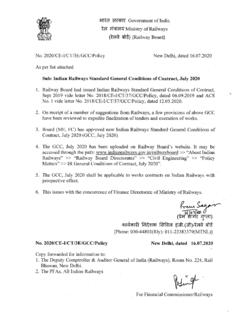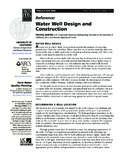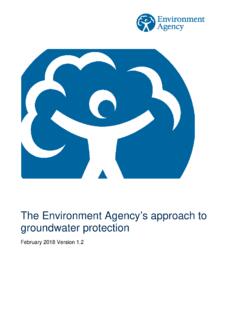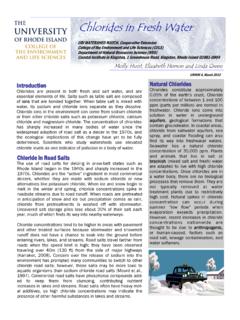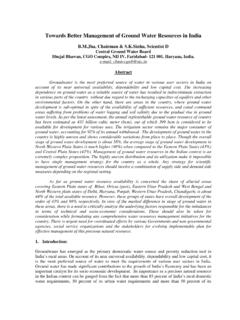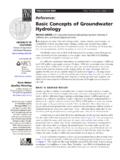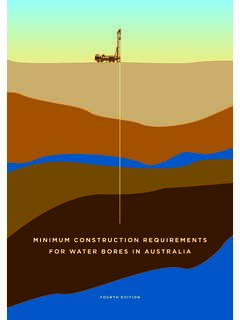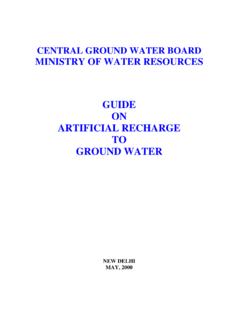Transcription of RAIN WATER HARVESTING - iricen.gov.in
1 RAIN WATERHARVESTINGO ctober 2015 Indian Railways Institute of Civil EngineeringPune 411001 Price < 30/-First Edition:Second Edition:October 2015 Revised EditionAugust 2006iRAIN WATERHARVESTINGINDIAN RAILWAYS INSTITUTE OF CIVIL ENGINEERING,Pune 411001 October 2015iiiiiPreface to the Second EditionWith regard to WATER , urban areas in India are facing a paradoxicalsituation these days. On the one hand there is acute WATER scarcityand on the other, the streets are flooded during rains. This reflectsmanagerial inefficiency of the urban local bodies to use the surpluswater of the rainy season to overcome the deficiency in otherseasons. The current centralized WATER supply paradigm is definetlyunsustainable and extremely high on energy consumption. Theshortage of ground WATER gets more pronounced with urbanizationand limited open areas available for recharge of ground WATER . Watershortage may result in social conflicts, demonstrations, protests androad- blockades.
2 In the given situation rain WATER HARVESTING canprove to be a alternative paradigm for more sustainable WATER availabilityis HARVESTING rainwater, storing it in tanks, and recharginggroundwater. In India, Rain WATER HARVESTING has been in practicefor more than 4000 years. The physical and chemical properties ofrainwater are mostly superior to that of first step could be to initiate domestic rooftop rainwaterharvesting. In a house the highest point is the rooftop. However,common property resource issues have to be considered at largerlevel for rain WATER HARVESTING . Various government bodies of Indiahave issued policy directives for encouraging this practice especiallysince 2002. In 2013 Ministry of Railway has also issued policyguideline to adopt rain WATER HARVESTING in all projects. The book on Rain WATER HARVESTING will create awareness andaccordingly will guide engineers in using this technology in aenvironment friendly October, 2015 Vishwesh ChaubeyDirectorIndian Railways Institute ofCivil Engineering, to the First EditionWe, the human beings, are largely dependent on WATER for oursurvival.
3 Although WATER is as important for survival of human beingsas much as food, air etc. but we hardly pay any attention for itseconomical use and conservation of this precious to indiscriminate pumping of ground WATER , the WATER tablehas already gone down abnormally and if we do not wake up evennow then our future generations may have to face severe crisis ofwater. The rains are important source of WATER and if we can harvestrain WATER , the scarcity of WATER can be eliminated , it is our bounden duty to conserve the rain WATER in theform of rain WATER book on Rain WATER HARVESTING is an attempt by IRICENto propagate the concept of rain WATER HARVESTING which can beeffectively implemented in our office and residential is hoped that this will serve as a helpful guide to the field KumarDIRECTORIRICEN, PunevAcknowledgementThe rapid development of cities and consequent populationexplosion in urban areas has led to depletion of surface waterresources.
4 For fulfillment of daily WATER requirement, indiscriminatepumping of ground WATER is being resorted to, leading to lowering ofground WATER table. At the same time the rain WATER is not beingconserved which ultimately goes waste. To avoid this imbalance,conservation of rain WATER in the form of rain WATER HARVESTING is theonly WATER HARVESTING can be effectively implemented in our officeand residential complexes for conservation of rain WATER . The subjecthas assumed lot of significance in the present scenario. This hasbeen included in Indian Railway Works Manual 2000 vide correctionslip no. 10 dated also. This publication is an attempt tocompile all the relevant information regarding various methodscommonly in use. These methods can be used by field engineersfor designing and implementing Rain WATER HARVESTING have been made to make the book more useful for thefield engineers.
5 In this effort, the IRICEN staff and faculty havecontributed immensely, notably among them are Mrs. Gayatri Nayakand Shri Sunil Pophale. I am particularly thankful to Shri Sharda,Senior Professor/Works for his valuable suggestions and proofchecking and Shri Praveen Kumar, Professor/Computers forproviding logistic assistance for printing of the all, the author is grateful to Shri Shiv Kumar, Director,IRICEN for his encouragement and suggestions for improving K. GuptaProfessor/TrackIRICEN/PuneviviiCONT ENTSCHAPTER-1 GENERAL1 - Hydrologic Advantages of rain Rain WATER Advantages of rain WATER From where to rain WATER Rain WATER HARVESTING Factors affecting run off from Important points relating to WATER storageand rechargingCHAPTER-2 METHODS OF HARVESTINGRAIN WATER12 - Rain WATER HARVESTING Storing rain WATER for direct Recharging ground WATER aquifers fromroof top Recharging ground WATER aquifers withrunoff from ground Components of rain WATER Catchment Coarse mesh/leaf Down First flushing Settlement Storage tankCHAPTER-3 RECHARGING SUBSURFACEAQUIFERS32 - Methods of recharging subsurface Through recharge Recharge through abandoned hand Recharge through abandoned dug well/open
6 Through recharge Recharge through Recharge trench with boreCHAPTER-4 CASE STUDY40 - Rain WATER HARVESTING at IRICEN hostelCHAPTER-5 QUALITY OF WATER45 - 50 REFERENCES511 CHAPTER - 1 GENERALIt is said that If third world war take places it will be on WATER .Already so many WATER disputes are going on in our countrybetween neighboring states for sharing river WATER . Same situationof sharing river WATER also exists with neighboring countries likePakistan, Nepal and Bangladesh. The basic reason of all thesedisputes is scarcity of WATER and increasing requirement for humanconsumption as well as for , the human beings, are largely dependent on WATER forour survival. Although WATER is as important for survival of humanbeings as is food, air etc. but we hardly pay any attention for itseconomical use and conservation of this precious resource . Thisis resulting in scarcity of to indiscriminate pumping of ground WATER , the WATER tablehas already gone down abnormally in many parts of our countryand if we do not wake up even now, then our future generationsmay have to face severe crisis of Delhi the WATER level in 1960 was, by and large, within 4 to5 m from ground level but by 2001 it has gone down by 2-6 m inalluvial areas, 8-20 in south west district and 8-30 in south to rapid urbanization and indiscriminate pumping groundwater table has gone very deep and due to high content of solublesolid, it has become un-potable in many rains are important source of WATER and if we can harvestrain WATER , the scarcity of WATER can be eliminated upto largeextent.
7 A major portion of rainwater that falls on earth surfacerunoff from stream to river to sea. On average only 8% of totalrainfall recharges ground aquifers. This can be enhanced upto250% with proper rainwater HARVESTING . Therefore, it is our boundenduty to conserve the rain WATER in the form of rain WATER basic facts we should know: Only 3% of WATER on earth is available for human use. Only 10% rain WATER is harvested currently. This can beenhanced to 50% if adopted as habit or movement. Thiscan solve WATER problems of major part of country. On an average rains, occur only for about 100 hours on Rain WATER HARVESTING in India Under the sec 15 of Environment (protection) Act 1986central ground WATER authority (ministry of WATER resources)has made mandatory to adopt rain WATER harvestingsystem for certain types of buildings /institutions locatedin specified regions of national capital territory.
8 Ministry of Environment & forest (Govt. of India) hascirculated draft Gazette Nomination regarding RWH inhilly area of entire country. New Delhi - MOUD has made RWH mandatory since June2001 if roof area = 100sqm or plot area = 1000sqm. Mumbai: RWH mandatory since Oct 2002 for newbuildings with area = 1000 sqm. Chennai: RWH has been made mandatory in all newbuildings of three or more storeys. Hyderabad: RWH made mandatory since June 2001 ifarea = 300 sqm. Kanpur : RWH made mandatory for new buildings witharea = 1000 sqm. Indore : RWH made mandatory for new buildings if area = Rebate of 6% in property tax as incentive for RWH. Rajasthan: RWH made mandatory for new buildings inurban areas if plot area = 500 sqm. Haryana: HUDA has made RWH mandatory for new buildings inurban areas irrespective of area. CGWA has asked all institutions and residential buildingsin notified areas of Gurgaon and adjacent industrial areasto go for of Railways (Railway board vide their letter dated2013/JMB/9/1 dtd 09-9-2013 has issued policy instructionto adopt Rain WATER HARVESTING scheme in all IntroductionWater is the most common or major substance on earth,covering more than 70% of the planet s surface.)
9 All living thingsconsist mostly of WATER . For example, the human body is abouttwo third WATER . World wide distribution of WATER is given in of the total volume of WATER , only 2 percent (over 28,000,000Km3) is fresh WATER , which can be used for consumption and foragriculture as given in table The average runoff in the riversystem of India has been assessed as 1869 km3, of this, theutilizable portion by conventional storage and diversion isestimated as about 690 km3. In addition, there is substantialreplenishable ground WATER potential in the country estimated at432 km3. The per capita availability of WATER at the national levelhas reduced from about 5,177 m3 in the year 1951 to the presentlevel of 1,869 m3. For improving per capita WATER availability inthe country, replenishment of ground WATER resources is anecessity which can be done very effectively through rain World-wide distribution of waterS WATER TypeVolumePercentageN(1000km3)of total GlobalVolume1 Ocean1,370, water60, (fresh & saline)3 Glaciers24, and ,454, World-wide distribution of fresh waterS WATER TypeVolumePercentageN(1000km3)of total GlobalVolume1 Glaciers24, water4, and , WATER HARVESTING :The concept of rain WATER HARVESTING means Collecting Rainwater when and wherever it falls for future use.
10 It is just like bank account where you deposit the money when it is surplus& with draw when it is deficient .As most of rainfall WATER goes waste in form of surface run offto stream, river and sea, simple technique need to be developedto collect and store this WATER in storage tank or direct this waterto recharge ground WATER acquifers ( WATER bearing strata) to betapped later on for use in dry Hydrologic CycleThe never-ending exchange of WATER from the atmosphere tothe oceans and back is known as the hydrologic cycle ( ). This cycle is the source of all forms of precipitation (hail,rain, sleet, and snow), and thus of all the Hydrologic cyclePrecipitation stored in streams, lakes and soil evaporateswhile WATER stored in plants transpires to form clouds which storethe WATER in the , about 75% to 80% of conventional WATER supply isfrom lakes, rivers and wells. Making the most efficient use ofthese limited and precious resources is essential.







